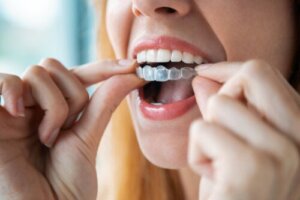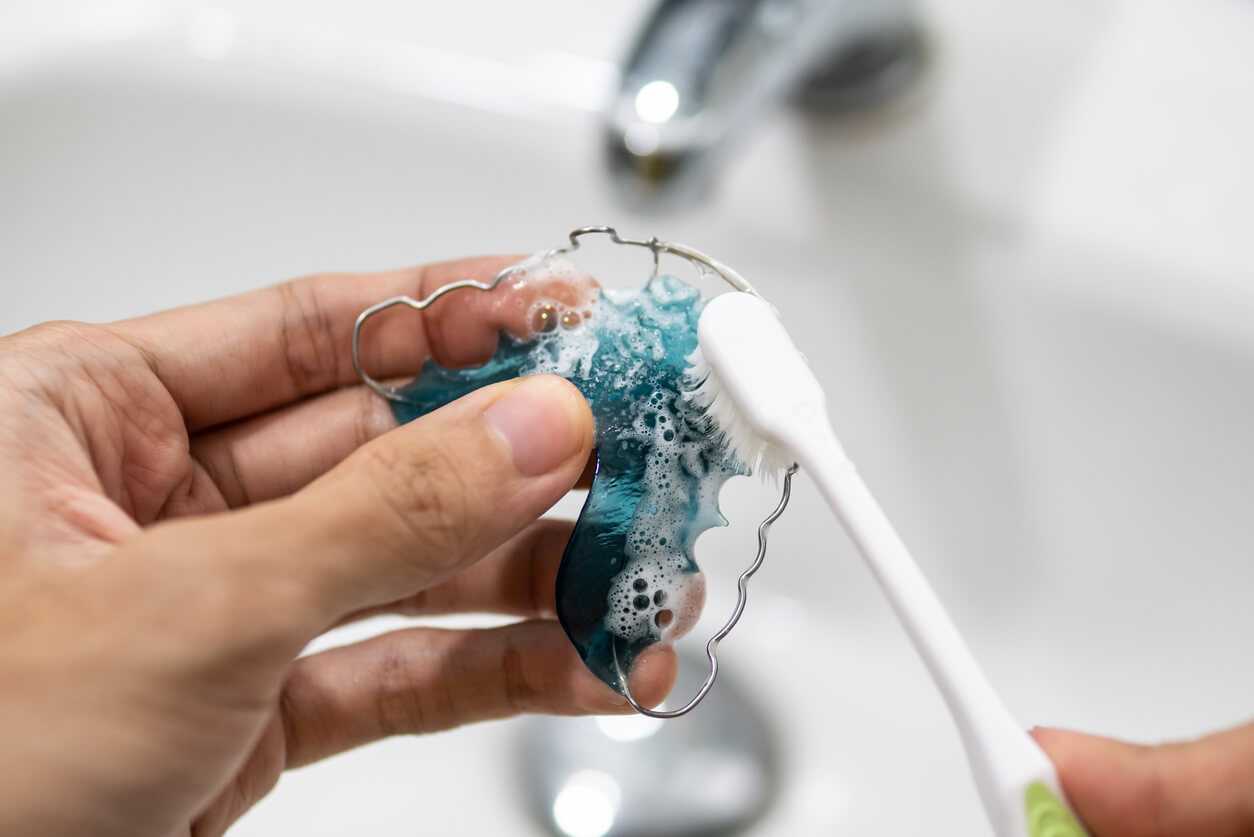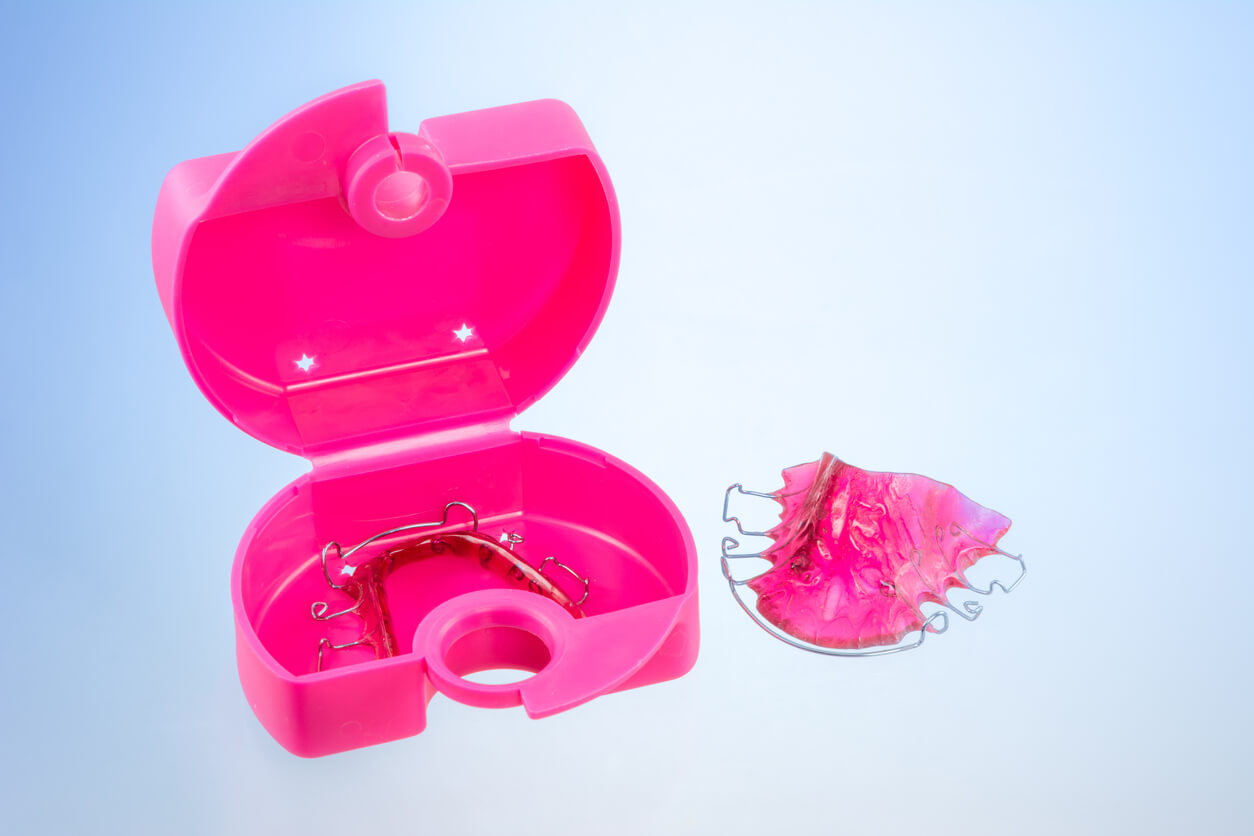How to Clean Removable Orthodontic Appliances


Written and verified by the dentist Vanesa Evangelina Buffa
In childhood, it’s quite common to use removable orthodontic appliances to treat bite problems and align teeth. In this article, we’ll tell you how to clean removable orthodontic appliances so you can keep them in good condition.
When used inside the oral cavity, appliances accumulate bacteria, food debris, plaque, and tartar. Therefore, to maintain the functionality of the device and avoid diseases in the mouth, it’s important to clean them properly every day. Discover how to clean your children’s removable orthodontic appliances and what you should do to keep them in good condition.
Removable orthodontic appliances in children
Detecting and addressing bite problems during childhood is the most convenient thing to do. At this stage, the jaw bones are developing and the teeth are in the process of erupting.
This situation allows the use of appliances that guide bone growth and positioning of the teeth. This is what we know as interceptive orthodontics, a branch of this specialty that treats bite problems at an early age to avoid more complex and severe anomalies in the future.
Removable orthodontics
There are different types of oral devices to solve the different situations that arise in the mouth. In children, removable orthodontic appliances are the most common, although there are also fixed options. The design of each appliance depends on the problem to be treated and the child’s own needs.
Clear aligners
Another type of removable orthodontic appliances that can be used in children is clear aligners, such as the Invisalign system. These are splints made of special polyurethanes that allow bite problems to be solved.
Removable orthodontic appliances have the advantage that they can be removed for cleaning and, at the same time, they allow you to sanitize the oral cavity in the usual way. They should also be removed at mealtimes, which reduces the retention of food in the appliance.

What happens if removable orthodontic appliances aren’t cleaned?
When using removable orthodontic appliances inside the oral cavity, if they’re not cleaned, there’s an increased risk of bacteria and debris accumulating on their structure. Over time, they can change color, begin to smell, taste bad, and have a strange texture.
The same bacteria that accumulate on the teeth and mucous membranes of the mouth can proliferate in the appliances. Even the accumulation of residue in these devices can cause an imbalance in the normal flora of the oral cavity and favor the appearance of diseases. Cavities, gingivitis, and candidiasis are some of the diseases that can develop.
How are they cleaned?
When it comes to cleaning your child’s removable orthodontic appliances, the first thing you should do is talk to their orthodontist. The professional will guide you regarding the practices you should perform. The way to clean braces may vary depending on the design of each device. However, there are some simple methods that will help you keep them germ-free.
Daily cleaning
The appliance should be cleaned every day and, if possible, every time the child takes them out to eat and brush their teeth. Hygiene should ideally be performed as soon as the appliance is removed from the mouth, while it’s still wet, to prevent residues from drying and hardening.
It’s best to clean the appliance with a soft bristle brush intended for this purpose. If necessary, a cotton swab can be used to access the more difficult areas, such as ridges, grooves, and cavities.
The appliance should be brushed under a stream of warm or cold water, never very hot, in order to rinse and remove residues. Also, some neutral or very mild liquid soap can be used. Note that toothpaste shouldn’t be used, as its abrasive components could scratch the surfaces of the device.
After cleaning, the device should be rinsed thoroughly and dried with paper towels. Before placing it back in the mouth, it’s advisable to moisten it. It’s also advisable for the child to brush their teeth at this time.
Cleaning tablets
Once a week or every ten days, it’s advisable to perform a more thorough cleaning with special tablets designed for the hygiene of appliances and dentures. This is a disinfectant and effervescent product that, through the bubbles produced, manages to remove the residue that brushing can’t remove.

Other care measures to maintain removable orthodontic appliances
There are other care measures that will help you keep your removable orthodontic appliances intact so that they fulfill their function in your mouth. Here are some tips to consider:
- Avoid heat: High temperatures can deform and ruin the appliance. Therefore, keep it away from boiling water, microwaves, dishwashers, and dryers.
- Don’t use chemical products: Water, mild soap, and occasional effervescent tablets are sufficient for cleaning the appliance. Don’t use other products containing alcohol that could damage the appliance or cause other reactions in the mouth.
- Clean its case: Just as you clean your removable orthodontic appliances, you should also sanitize their storage case regularly.
- Keep it in its case: When not in use, the appliance should be kept in its case in a safe place. This helps to avoid mishaps such as not remembering where it is, being accidentally thrown in the trash, or even being chewed on or swallowed by a pet.
- Dry it: When stored in its box, the device should be dry. If it’s stored damp in a closed place, fungus and bad odors may appear.
- Don’t adjust or tinker with it: If your child is uncomfortable with their device or you notice that something’s loose, you shouldn’t handle it with pliers, tweezers, or other items, as you risk damaging it. If something’s wrong with the appliance, you should go to the orthodontist.
- Check it frequently: Going to dental check-ups so that the professional can verify that the appliance is doing its job is essential. At these checkups, the integrity of the appliance is evaluated and any necessary adjustments are made.
You have to accompany the treatment
Wearing orthodontics during childhood allows you to solve bite problems early and avoid complications in the future. Keeping the appliances intact and clean helps to maintain the health of the oral structures and for the treatment to be successful.
Now that you know how to clean removable orthodontic appliances, you can avoid mishaps during your child’s treatment. With your guidance, their smile will be healthy and beautiful.
In childhood, it’s quite common to use removable orthodontic appliances to treat bite problems and align teeth. In this article, we’ll tell you how to clean removable orthodontic appliances so you can keep them in good condition.
When used inside the oral cavity, appliances accumulate bacteria, food debris, plaque, and tartar. Therefore, to maintain the functionality of the device and avoid diseases in the mouth, it’s important to clean them properly every day. Discover how to clean your children’s removable orthodontic appliances and what you should do to keep them in good condition.
Removable orthodontic appliances in children
Detecting and addressing bite problems during childhood is the most convenient thing to do. At this stage, the jaw bones are developing and the teeth are in the process of erupting.
This situation allows the use of appliances that guide bone growth and positioning of the teeth. This is what we know as interceptive orthodontics, a branch of this specialty that treats bite problems at an early age to avoid more complex and severe anomalies in the future.
Removable orthodontics
There are different types of oral devices to solve the different situations that arise in the mouth. In children, removable orthodontic appliances are the most common, although there are also fixed options. The design of each appliance depends on the problem to be treated and the child’s own needs.
Clear aligners
Another type of removable orthodontic appliances that can be used in children is clear aligners, such as the Invisalign system. These are splints made of special polyurethanes that allow bite problems to be solved.
Removable orthodontic appliances have the advantage that they can be removed for cleaning and, at the same time, they allow you to sanitize the oral cavity in the usual way. They should also be removed at mealtimes, which reduces the retention of food in the appliance.

What happens if removable orthodontic appliances aren’t cleaned?
When using removable orthodontic appliances inside the oral cavity, if they’re not cleaned, there’s an increased risk of bacteria and debris accumulating on their structure. Over time, they can change color, begin to smell, taste bad, and have a strange texture.
The same bacteria that accumulate on the teeth and mucous membranes of the mouth can proliferate in the appliances. Even the accumulation of residue in these devices can cause an imbalance in the normal flora of the oral cavity and favor the appearance of diseases. Cavities, gingivitis, and candidiasis are some of the diseases that can develop.
How are they cleaned?
When it comes to cleaning your child’s removable orthodontic appliances, the first thing you should do is talk to their orthodontist. The professional will guide you regarding the practices you should perform. The way to clean braces may vary depending on the design of each device. However, there are some simple methods that will help you keep them germ-free.
Daily cleaning
The appliance should be cleaned every day and, if possible, every time the child takes them out to eat and brush their teeth. Hygiene should ideally be performed as soon as the appliance is removed from the mouth, while it’s still wet, to prevent residues from drying and hardening.
It’s best to clean the appliance with a soft bristle brush intended for this purpose. If necessary, a cotton swab can be used to access the more difficult areas, such as ridges, grooves, and cavities.
The appliance should be brushed under a stream of warm or cold water, never very hot, in order to rinse and remove residues. Also, some neutral or very mild liquid soap can be used. Note that toothpaste shouldn’t be used, as its abrasive components could scratch the surfaces of the device.
After cleaning, the device should be rinsed thoroughly and dried with paper towels. Before placing it back in the mouth, it’s advisable to moisten it. It’s also advisable for the child to brush their teeth at this time.
Cleaning tablets
Once a week or every ten days, it’s advisable to perform a more thorough cleaning with special tablets designed for the hygiene of appliances and dentures. This is a disinfectant and effervescent product that, through the bubbles produced, manages to remove the residue that brushing can’t remove.

Other care measures to maintain removable orthodontic appliances
There are other care measures that will help you keep your removable orthodontic appliances intact so that they fulfill their function in your mouth. Here are some tips to consider:
- Avoid heat: High temperatures can deform and ruin the appliance. Therefore, keep it away from boiling water, microwaves, dishwashers, and dryers.
- Don’t use chemical products: Water, mild soap, and occasional effervescent tablets are sufficient for cleaning the appliance. Don’t use other products containing alcohol that could damage the appliance or cause other reactions in the mouth.
- Clean its case: Just as you clean your removable orthodontic appliances, you should also sanitize their storage case regularly.
- Keep it in its case: When not in use, the appliance should be kept in its case in a safe place. This helps to avoid mishaps such as not remembering where it is, being accidentally thrown in the trash, or even being chewed on or swallowed by a pet.
- Dry it: When stored in its box, the device should be dry. If it’s stored damp in a closed place, fungus and bad odors may appear.
- Don’t adjust or tinker with it: If your child is uncomfortable with their device or you notice that something’s loose, you shouldn’t handle it with pliers, tweezers, or other items, as you risk damaging it. If something’s wrong with the appliance, you should go to the orthodontist.
- Check it frequently: Going to dental check-ups so that the professional can verify that the appliance is doing its job is essential. At these checkups, the integrity of the appliance is evaluated and any necessary adjustments are made.
You have to accompany the treatment
Wearing orthodontics during childhood allows you to solve bite problems early and avoid complications in the future. Keeping the appliances intact and clean helps to maintain the health of the oral structures and for the treatment to be successful.
Now that you know how to clean removable orthodontic appliances, you can avoid mishaps during your child’s treatment. With your guidance, their smile will be healthy and beautiful.
All cited sources were thoroughly reviewed by our team to ensure their quality, reliability, currency, and validity. The bibliography of this article was considered reliable and of academic or scientific accuracy.
- Rodriguez, G. N. P., Davila, Á. A. A., & Dávila, M. P. A. (2022). Beneficios de la implementación de ortodoncia interceptiva. RECIAMUC, 6(2), 69-78.
- Campuzano, T. M., Torres, M. F. M., & Rosales, A. M. (2020). Revisión sistemática sobre los tipos de tratamientos relacionados con la Ortodoncia Interceptiva en jóvenes y niños. Revista Científica Especialidades Odontológicas UG, 3(1), 127-131.
- Bryan, C. M. C., Stalin, M. S. D., & Jéssica, S. O. (2021). Prevalencia de Candida spps en aparatología ortodóntica en pacientes pediátricos. Revista Killkana Salud y Bienestar. Vol, 5(3).
- Dávila Pinguil, L. A. (2019). Prevalencia de gingivitis en pacientes con prótesis parcial removible y pacientes con tratamiento ortodóntico (Bachelor’s thesis, Universidad de Guayaquil. Facultad Piloto de Odontología).
- Marmolejos, C., & Ovalle, E. (2021). Ortodoncia interceptiva.
- Quizhpe Veintimilla, S. P. (2019). Presencia de enterobacterias y enterococcus faecalis en la aparatología ortodóntica de los pacientes pediátricos en la clinica de ortodoncia de la Universidad Católica de Cuenca en el año 2018.
- Lozano Lozano, T. A., & Triana Aroca, J. A. (2021). Microorganismos prevalentes en prótesis totales, aparatología ortopédica y sus manifestaciones orales. Reporte de literatura 2014-2020.
This text is provided for informational purposes only and does not replace consultation with a professional. If in doubt, consult your specialist.








